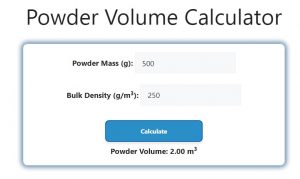About Powder Volume Calculator (Formula)
The Powder Volume Calculator is an essential tool for scientists, pharmacists, and manufacturers working with powdered substances. This calculator helps users determine the volume of powder based on its mass and bulk density, providing crucial information for various applications, including formulation and quality control. Understanding powder volume is essential for achieving accurate dosages in pharmaceuticals, optimizing material usage in manufacturing, and ensuring consistency in product quality.
Formula
The formula used in the Powder Volume Calculator is: PV = PM / BD, where PV is the powder volume, PM is the powder mass (in grams), and BD is the bulk density (in grams per cubic meter). This formula enables users to convert the mass of a powder into its corresponding volume, facilitating better planning and formulation processes.
How to Use
Using the Powder Volume Calculator is straightforward. Here’s how to do it:
- Input Powder Mass: Enter the mass of the powdered substance in grams (g).
- Input Bulk Density: Enter the bulk density of the powder in grams per cubic meter (g/m³).
- Calculate: Click the “Calculate” button to obtain the volume of the powder. The result will indicate how much space the powder occupies, allowing for effective formulation and mixing.
Example
Suppose you have the following data:
- Powder Mass (PM): 500 g
- Bulk Density (BD): 250 g/m³
Using the formula:
PV = PM / BD
PV = 500 g / 250 g/m³
PV = 2 m³
This means that a powder mass of 500 grams occupies a volume of 2 cubic meters.

FAQs
1. What is powder volume?
Powder volume refers to the amount of space occupied by a powdered substance, typically expressed in cubic meters or milliliters.
2. Why is powder volume important?
Understanding powder volume is crucial for accurately dosing medications, optimizing ingredient usage in manufacturing, and ensuring uniformity in products.
3. How do you measure bulk density?
Bulk density is typically measured by dividing the mass of a powder by its volume, often using a graduated cylinder or specialized equipment.
4. Can I use this calculator for any type of powder?
Yes, the Powder Volume Calculator can be used for any powdered substance as long as you know its mass and bulk density.
5. What units are used in the Powder Volume Calculator?
The calculator uses grams for mass and grams per cubic meter for bulk density. The resulting volume is in cubic meters.
6. How does bulk density affect powder volume?
Higher bulk density indicates that a powder is more compact, resulting in a smaller volume for the same mass compared to a powder with lower bulk density.
7. What if I don’t know the bulk density of my powder?
If the bulk density is unknown, you may need to conduct tests to determine it or refer to published data for that specific powder.
8. How can I convert the volume to liters?
To convert cubic meters to liters, multiply the volume in cubic meters by 1,000 (1 m³ = 1,000 L).
9. Can the calculator be used for liquids?
No, the Powder Volume Calculator is specifically designed for powdered substances and their mass and bulk density.
10. Is there a difference between bulk density and true density?
Yes, bulk density includes the volume of the powder as well as the void spaces between particles, while true density measures only the mass of the particles themselves.
11. How does moisture content affect bulk density?
Moisture can increase the mass of the powder without significantly affecting the volume, leading to a higher bulk density and potentially inaccurate calculations.
12. What industries use powder volume calculations?
Industries such as pharmaceuticals, food production, cosmetics, and materials science frequently use powder volume calculations for various applications.
13. Can I input decimal values for mass and bulk density?
Yes, the calculator accepts decimal values for both mass and bulk density for more precise calculations.
14. What are some common powdered substances?
Common powdered substances include flour, sugar, baking powder, and pharmaceutical powders.
15. How can inaccurate bulk density affect my results?
Inaccurate bulk density can lead to incorrect volume calculations, potentially resulting in formulation errors and product inconsistencies.
16. Is the Powder Volume Calculator useful for research purposes?
Yes, researchers can use this calculator for experiments involving powdered materials and their properties.
17. Can I use the calculator for bulk powders and fine powders?
Yes, the calculator is applicable to both bulk and fine powders as long as their mass and bulk density are known.
18. What is the typical range for bulk density values?
Bulk density values can vary widely depending on the powder, ranging from less than 100 g/m³ for very light powders to over 1,000 g/m³ for heavy powders.
19. How often should I recalculate powder volume?
Recalculate the powder volume whenever there is a change in the mass or bulk density of the powder used.
20. Can I use this information for packaging design?
Yes, knowing the powder volume is essential for designing packaging that accommodates the required amount of powder without wastage.
Conclusion
The Powder Volume Calculator is an invaluable resource for anyone working with powdered substances. By accurately determining the volume based on mass and bulk density, users can enhance their formulation processes, ensure consistency in production, and meet regulatory standards. Whether in pharmaceuticals, food production, or research, understanding powder volume is key to achieving desired outcomes and maintaining product quality.